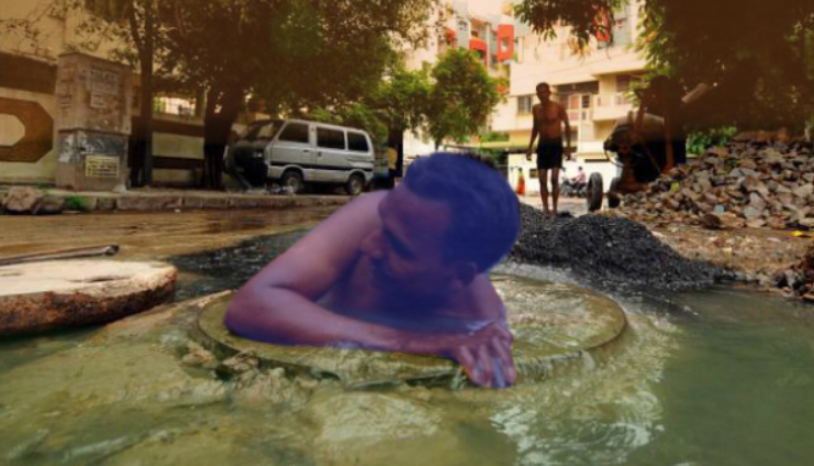Mounting Sewer Deaths: What Spar Between NCSK and Delhi Government Shadows

Representational Image
Addressing a press conference, National Commission for Safai Karamcharis Chairman Manhar Valjibhai Zala on Tuesday said that the national capital Delhi has witnessed 64 deaths of manual scavengers since 1993. The figure included 38 deaths in the last two years. Zala also claimed that Delhi government did not act proactively in compensating the families of the victims and their further rehabilitation. So far, it has only compensated 46 victims with Rs 10 Lakh and 18 families are awaiting compensation.
The press meet was soon followed by a spar between Delhi Social Welfare Minister Rajendra Pal Gautam and another commission member Gangaram Ghoshare. While Gautam emphasised that the Delhi government has ensured active intervention to eradicate manual scavenging, Ghoshare referred to the unfulfilled promises of the Delhi government. Unfortunately, the spar hit the headlines and the plight of the manual scavengers took a backstage.
Delhi, apart from being the national capital of the country, is also home to 69,640 dry latrines. Dry latrines are medieval-age toilets where the human excreta are removed by manual scavenges who carry it over their head to dump in remote places. Although, the practice was banned by Prohibition of Employment of Manual Scavengers and Their Rehabilitation Act 2013, it is still exercised by lakhs of manual scavengers in the country. Given the rampant practice of manual scavenging, the numbers of deaths quoted by NCSK appeared too low in the light of the fact that a manual scavenger loses his life every fifth day in the country. The recent death of five manual scavengers in a posh colony in Moti Nagar has further exposed the violation of the act.
Clarifying about the number of deaths, NCSK Gangaram Ghoshare admitted that the number does not reveal the true picture of the crisis. Ghosare told NewsClick, “The commission collects the data about sewer deaths from various state governments. Now, we have seen that the state governments have been under-reporting deaths to escape their constitutional duties of identifying the manual scavengers and rehabilitating them. It further saves them from disbursing the compensation mandated by the Supreme Court. That is why we have asked the three departments—Delhi Jal Board, Municipal Corporations of Delhi and the Delhi Police—to report these deaths to reach a conclusive figure.”
Ghoshare also did not mince any words while speaking about the failure of the Delhi government in compensating the victims who died while cleaning the sewers, septic tanks and manholes. He added, “The sanitation workers had gone on strike for three months in 2015. What they were demanding was health cards that could help them avail benefits of free treatment. Still, they are awaiting these cards even after three years. Similarly, out of 200 cleaning machines acquired by the Delhi Government, only 38 have been issued to the workers and 86 were used by the supervisors who in turn employ workers. Why can’t they hand it over to the workers?”
National Picture
The understated estimates of National Commission for Safai Karamchari say that at least 814 manual scavengers have lost their lives since 1993. Tamil Nadu has recorded 210 deaths, Gujarat recorded 156, followed by UP and Haryana with 77 and 70 deaths, respectively. However, many states including BJP-ruled Gujarat fared poorly regarding the compensation for the victims’ families. As per the guidelines issued in Safai Karamchari Andolan verus Union of India by the Supreme Court, each victim’s family should be compensated with Rs 10 Lakh. While Tamil Nadu compensated 75% victims, Gujarat compensated in only 30% cases.
However, the data collated by Safai Karamchari Andolan maintain that at least 1,760 people have lost their lives while cleaning the sewers since 1993. Interestingly, Indian Railways remained the largest employer of manual scavengers in India with 36,176 cleaners. The Socio-economic Census of India 2011 had further revealed a horrifying picture. It revealed that there were 7,40,078 households across the country which employed manual scavengers to remove human excreta by a person from a dry latrine. It further stated that 1,82,505 families were engaged in manual scavenging.
Also read: 5 Sanitation Workers from Bihar Suffocate to Death in Ghaziabad
Get the latest reports & analysis with people's perspective on Protests, movements & deep analytical videos, discussions of the current affairs in your Telegram app. Subscribe to NewsClick's Telegram channel & get Real-Time updates on stories, as they get published on our website.
























